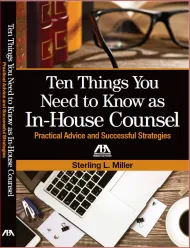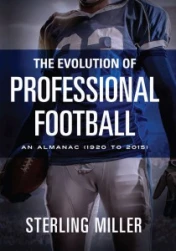[I realized too late after my last post that I have surpassed 100 blogs. Wow. No celebration but, to be honest, I never imagined I’d write that many when I started “Ten Things” back in November 2014. But, here we are, all dressed up and lots of places still to go. So, thanks for reading and keep those emails and suggestions coming!]
As an in-house lawyer, I was always interested in any legitimate way I could keep information generated by the company or the legal department confidential. Or, more importantly, out of the hands of our adversaries. All of which meant I needed to stay on top of many things, from trade secret protection to teaching the business to write smart. But, as a lawyer, I had a particular interest in how privilege might apply to the materials I – or my team – was working on. The most obvious was the attorney-client privilege, something I have written about in a past blog and which ranks first on my list in terms of protecting information. Somewhat less obvious, and not as sexy as its cool, buff older brother, is the work product privilege. While more limited in the circumstances in which it applies, it is pretty powerful and can save the day when something happens to make the attorney-client privilege fall away. Kind of how Batman can curb-stomp some villains when Superman’s having an off day. I think it’s time we gave the work product privilege some love and this edition of “Ten Things” discusses what in-house lawyers need to know about our new, best buddy:[1]
1. What is the work product privilege? First, I discovered that it’s not really considered a “privilege” in the pure sense of the word. It’s actually considered a “doctrine” or a rule. But that’s boring so I’m am going to keep calling it a privilege because … well, because I can and it sounds much more glamorous than doctrine (a word that conjures up images of President Fillmore orating from the back platform of a railroad car). The privilege was first set out in 1947 by the Supreme Court in a case called Hickman v. Taylor. A few decades later, the privilege was codified into the Federal Rules of Civil Procedure in what is now Rule 26. Most U.S. states have equivalent rules in their civil procedure codes (but for my purposes I am going to discuss the federal version). The work product privilege protects from discovery those “documents and tangible things” that are “prepared in anticipation of litigation” by (or for) a party or its representative. A party seeking discovery may overcome the work product privilege if they can show they have a “substantial need” for the materials to prepare their case and they cannot obtain the substantial equivalent of the other party’s work product through “other means” without “undue hardship.” However, even if a party can show such a need, courts must (and will) protect from disclosure attorney-client communications and the “mental impressions, conclusions, opinions, or legal theories” of a party’s attorney or other representatives concerning the litigation.
2. Must be prepared in anticipation of litigation. This is the key to seeking work product protection, the materials must have been prepared in anticipation of litigation. Without this fact present, the materials are not protected. And many in-house (and outside) lawyers mistakenly think all their notes and thoughts are protected by the privilege. They’re not. Which means when you are jotting down thoughts about a merger or a contract, don’t think the work product privilege applies. And unless the attorney-client privilege applies (which requires a communication, among other things) there may be nothing protecting those notes and thoughts. Similarly, reports and materials produced in the ordinary course of the business do not qualify as work product. What qualifies as “anticipation” of litigation is mixed. Some courts require an actual claim or specific threat be on file or made. Others are looser, anywhere from “real and imminent” to “substantial probability” to “fairly foreseeable.” As to the documents created, courts use one of three tests:
- “Because of” – under the facts, the document “can fairly be said to have been prepared or obtained because of the prospect of litigation.” This is the majority test and easier to meet than the next two.
- “Primary motivating factor” – preparation for litigation must have been the primary motivation for the creation of a document.
- “For use in” – only documents created specifically for use in litigation are protected by the work product privilege (by far the most restrictive test but is limited to just a few jurisdictions).
Yep, all clear as mud with lots of latitude for different judges to see the same document and come to different conclusions. Bottom line is you should check in the jurisdictions where your company operates/you practice and try to understand the standard used there.
3. What constitutes “litigation”? The good news for those looking to assert the privilege is that what can qualify as “litigation” is fairly broad, including:
- Judicial proceedings.
- Arbitration.
- Mediation.
- Administrative proceedings.
- Government investigation.
- Grand jury investigation.
- Subpoenas.
- Letter/communication threatening litigation.
- On-going class actions or similar multiple-front litigation (think toxic tort litigation in multiple jurisdictions for example).
- Preparing a complaint.
- Internal investigations.
In-house counsel can also trigger a “litigation” event by documenting the concern of litigation, engaging counsel, or otherwise planning on litigation in some manner. Just note that if you are going to rely on the work product privilege because you truly anticipate litigation you should have a litigation hold in place from that day forward. If not, you may have a hard time explaining to the court why documents were deleted or destroyed thereafter – even if in the normal course of your record retention program. Not everyone agrees with this view, but since judges are unpredictable and nothing is certain I prefer to err on the side of caution as I have been on the bad end of some very weird and twisted privilege rulings over the years.
4. Who can create work product? Obviously, attorneys can create work product but so can the client. This means your colleagues on the business side of the house can create privileged documents if (big if) they were created in anticipation of litigation. This also means it’s worth training the business on how best to draft, label, and document when something is created in anticipation of litigation. Additionally, agents, consultants, experts (testifying or not), and so on can create protected work product if they are a “representative” of the client or attorney. Accordingly, you may be able to protect work product created by a public relations firm, accountants, and others in ways the attorney-client privilege does not permit. With respect to representatives, you should document the anticipated (or actual) litigation in your engagement letter or in other documentation so it’s clear why their work product is protected.
5. How does the work product privilege differ from the attorney-client privilege? As you can see from the above, there are some big differences between the two. Work product only applies to materials prepared in anticipation of litigation and it is not absolute. As discussed below, the other side may have access to certain work product materials if they can satisfy certain conditions. And, the work product privilege typically lasts as long as there is litigation unlike the “forever-ness” of the attorney-client privilege. But, the work product privilege brings some big pluses to the table:
- There does not need to be a communication for the privilege to apply, nor does it necessarily need to be confidential.
- Work product does not need to be “legal advice.”
- It’s difficult to waive the work product privilege, e.g., providing it to “friendly” third-parties (like between father and son) is not a waiver.
- Work product can easily be created by the client and by representatives without involving a lawyer.
When preparing documents when anticipating or during litigation, it is great if you can – legitimately – claim both attorney-client and work product privilege. This can be a game changer in litigation where you somehow waived the attorney-client privilege but the work product privilege rides in to save the day.
6. Overcoming the work product privilege. As mentioned, and unlike the attorney-client privilege, the work product privilege is not absolute. Rule 26(b)(3)(A) and (B) states:
… [work product] materials may be discovered if:
(i) they are otherwise discoverable under Rule 26(b)(1); and
(ii) the party shows that it has substantial need for the materials to prepare its case and cannot, without undue hardship, obtain their substantial equivalent by other means.
(B) Protection Against Disclosure. If the court orders discovery of those materials, it must protect against disclosure of the mental impressions, conclusions, opinions, or legal theories of a party’s attorney or other representative concerning the litigation.
Fortunately, as you see from 26(b)(3)(B), the ability to obtain work product is limited to fact work product. Opinion work product is, for all practical purposes, nearly absolutely protected against disclosure (as is any work product protected by the attorney-client privilege or other reason). In order to get at fact work product, a party must show both substantial need and the inability to obtain the substantial equivalent by other means (e.g., a deposition). As you can imagine, courts have developed multiple tests and standards for what constitutes “substantial need,” “undue hardship,” and “substantial equivalent.” Without going into all the detail, it’s fair to say that it takes truly special circumstances and a lot of effort to get fact work product. The most typical examples are statements or interviews of now deceased witnesses, photographs or video of an accident scene taken at the time of the accident, or situations where the cost or effort to duplicate the fact work product is truly prohibitive.
7. Who can assert it? The attorney-client privilege belongs to and can only be asserted by the client. Work product is different. Whoever creates work product has the right to assert the privilege – typically attorneys and their clients (or “representatives” of either). So long as it was created in anticipation of litigation and meets the other prongs of the test set out above in No. 1. Non-parties to the litigation usually cannot assert work product, though they may be able to assert attorney-client privilege which applies regardless of whether litigation is anticipated.
8. Waiver. Unlike the attorney-client privilege, it’s actually difficult to waive the work product privilege. For example, attorneys and clients are free to share the work product with third-parties – so long as the interests of the third-party and the client are aligned (legally, commercially, etc.). Courts have held that intentionally sharing work product with family, affiliated companies, PR consultants, insurance brokers, potential investors or acquiring company, investment bankers, business allies, through a compelled disclosure process, and/or to other similar persons, entities, or consultants does not waive the work product privilege. A party can waive the privilege, however, by disclosing it to an adversary directly or if the disclosure substantially increases the chances that the work product will get into the hands of an adversary. Including the work product in a public pleading or other filing (e.g., relying on the work product in court) will waive the privilege as will – in most circumstances – producing work product to the government. Of course, failing to assert the privilege is another way to waive it. Finally, like the attorney-client privilege, the work product privilege can be waived under the “crime-fraud” exception, i.e., there is no privilege if the client consulted the lawyer or uses the materials for the purpose of committing a crime or furthering a fraud.
9. Best Practices. There are some tricky aspects to the work product privilege – especially the fickleness of the courts – you need to keep in mind. Here are some best practices that will give you the best chance of maintaining it:
- Properly label any document or materials you create in anticipation of litigation. For example, “Attorney Work Product – Prepared in Anticipation of Litigation. Contains Impressions and Conclusions of Counsel.” Make it easy on the judge if there is a fight. Even better is to start the document off with something like, “We received an email from X threatening litigation over the Y contract. These notes are prepared in anticipation of litigation…” And don’t forget to put the litigation hold in place.
- Help the business with labeling and preparation. If litigation is anticipated, spend some time with the key people and explain how privilege works – work product and attorney-client. Similarly, make sure everyone in the legal department understands how it works and how to prepare and label documents and materials.
- If you’re going to share the work product with third-parties put in place a confidentiality agreement, joint defense agreement, common interest agreement or other agreement designed to ensure the materials are kept confidential and show that your interests are aligned.
- If you are writing notes of an interview weave in your impressions, conclusions, theories, opinions, etc. And don’t write out long, verbatim quotes that make it look more like a transcript. Alternatively, you can separate pure facts from your impressions, conclusions, etc. in the same document with the expectation that the “fact section” may not be privileged.
- If appropriate, label documents for both attorney-client and work product privilege. Either may save the day.
- Know how courts apply the work-product privilege in your jurisdiction. This can be a great project for a summer intern or a summer clerk at one of your law firms.
10. Resources. I have come across and used a number of excellent resources about privileges generally and the work product privilege specifically. If you want or need to go deeper, check out these free resources:
- Court decisions (federal and state) in the jurisdictions where your company operates, e.g., its headquarters and significant offices (and keep a running list/copies of key cases as you find them over time). Ask one of your law firms to present a CLE on the topic.
- Presnell on Privileges – a great blog discussing all things “privilege.”
- McGuire Woods’ Privilege Points – almost the equal to Presnell’s blog and worth subscribing to.
- Managing the Attorney-Client Privilege and Work Product Doctrine: Considerations for In-House Counsel (2015) (Greensfelder law firm White Paper).
- The Basics of Attorney-Client Privilege and Work Product Doctrine (2018) (Law Practice CLE materials)
- Attorney-Client and Work Product Privilege (2018) (Abhay Naduram – YouTube Presentation – Iowa State Bar Association).
- A Practitioner’s Summary Guide to the Attorney-Client Privilege and the Work Product Doctrine (2013) (Thomas E. Spahn, McGuire Woods LLP).
- Protecting Confidential Legal Information – A Handbook for Analyzing Issues Under the Attorney-Client Privilege and the Work Product Doctrine (2017) (David M. Greenwald & Michele L. Slachetka, Jenner & Block). This last item is almost 500 pages of everything you ever want to know about these two privileges.
*****
It is difficult to capture all the “ins and outs” and nuance of the work product privilege in a blog post like this. If you have a situation that requires more detail, any of the resources above can get you knee-deep in the gore in just a few minutes. It’s a powerful tool and, in my opinion, deserves more attention from in-house counsel than it typically gets. As in-house counsel, it is up to you to make the effort to ensure you understand and apply the privilege wherever possible. It’s an asset of the company and you need to treat it like one.
Sterling Miller
June 5, 2019
Follow me on Twitter @10ThingsLegal and LinkedIn where I post articles and stories of interest to in-house counsel frequently.
“Ten Things” is not legal advice nor legal opinion and represents my views only. It is intended to provide practical tips and references to the busy in-house practitioner and other readers. If you have questions or comments, please contact me at sterling.miller@sbcglobal.net.
I am pleased to announce that, after the successful sale of Marketo, Inc. to Adobe late last year, I have rejoined Hilgers Graben PLLC as Senior Counsel. I am based in their Dallas office. My law firm email is smiller@hilgersgraben.com. Reach out if you need anything. If you’re interested in a CLE for your department on any of my blog topics, including today’s, we can set that up.
I have three published books: Ten Things You Need to Know as In-House Counsel – Practical Advice and Successful Strategies, The Evolution of Professional Football, and The Slow-Cooker Savant. I am also available for speaking engagements, coaching, and consulting.



[1] Apologies in advance that this post is completely U.S.-centric but it’s worth you looking into the law and rules in any country or jurisdiction where you practice or conduct business to see if there is something similar and, if so, how it works.

One comment